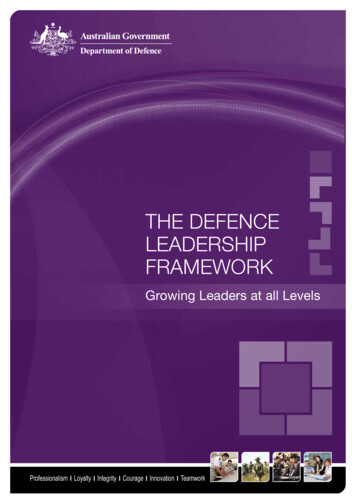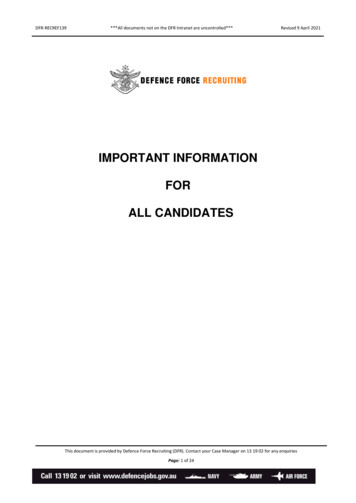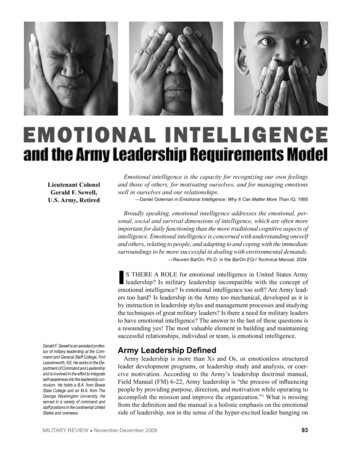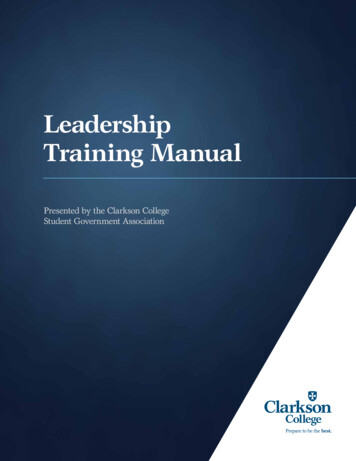
Transcription
the DefenceLeadershipframeworkGrowing Leaders at all LevelsProfessionalism ׀ Loyalty ׀ Integrity ׀ Courage ׀ Innovation ׀ Teamwork
ForewordOne of the founding elements of Building Force 2030, as outlined in the DefenceWhite Paper 2009, is the People Capability required to operate and support theequipment and systems, and to manage the business of Defence.Our organisation is complex with a compelling and unique mission. Generating ourfuture force and delivering our strategic reform program requires exceptional leaderswith the capacity to achieve the outcomes required by the Government, engagesuccessfully with the Australian community and effectively lead the military andAustralian Public Service people committed to a career in Defence.Defence must ensure the leadership, culture and behaviour of the organisationcreates a positive environment that builds commitment to perform at a highlevel. A key measure of success for this challenge is the extent to which our peoplebelieve Defence practices values-based leadership and is perceived as one ofAustralia’s pre-eminent institutions for developing leaders.In the following pages you will be introduced to the Defence LeadershipFramework that contains Defence’s desired leadership capabilities and behaviours.These behaviours operationalise the Defence, APS and Service Values to provideguidance for workplace behaviour and decisions. It is expected that our peoplemodel and promote our values together with the leadership behaviours as these areessential to the achievement of high performance and creating the positive climatewhere people are committed to give their best.The framework is based upon the non-operational leadership requirements ofDefence now, and into the future. It was developed through extensive research andconsultation with many stakeholders, including all the Groups and Services, as wellas external Government and private sector agencies. The framework, released in2006, was reviewed in early 2009 to ensure its currency and ongoing relevance tothe Defence mission. Defence acknowledges the assistance of the Australian PublicService Commission who provided guidance and research to assist in thedevelopment of the framework. The framework will continue to evolve especially inthe context of new approaches emerging from the APS reform process.The DLF has many practical applications for personal development, staff selection,performance management, succession planning; and career planning anddevelopment.I commend to you the framework for use in these practicalapplications to further build the leadership culture we aspire to.PHIL MINNSDeputy Secretary People Strategies and PolicyMarch 20101
Contents1 The Leadership Development Imperative2 Operationalising Defence Leadership3 The Defence Leadership Framework (DLF)4 A Comparative View of the DLF5 A Profile View of the DLF
1 The Leadership Development ImperativeLeadership – A whole of DefenceChallengeDefence requires leadersat every level, bothmilitary and civilianNo activity whether operational or nonoperational can be conducted effectively withoutthe motivation and inspiration provided by aleader. During the course a career in Defence,military or civilian, there will be times when allof us are called upon to take up a leadershiprole.Consequently leadership ability isfundamental for all Defence employees.Skilling DefenceLeadership is the processof influencing others inorder to gain their willingconsent in the ethicalpursuit of missionsOn 19 December 2002 the Defence Committeeendorsed a review of the way in which Defencedelivered training and development to build thebusiness skills among Defence employees. Thiswas termed business skilling.The committee agreed that the need to improvebusiness skills as a support to improvedbusiness management outcomes was anorganisational priority requiring a strategicapproach. The review was undertaken in thefirst half of 2003.The Report of the Review of the DefenceBusiness Skilling System dated 12 August 2003made23recommendationsfocusingonimplementing a system to improve businessskilling in Defence for both military and civilianemployees.Leadership is core toenabling many of themore specific businessskillsLeadership was identified as central tosuccessful business outcomes and there wasa notable requirement to enhance skilling ofcivilian employees.A leadership frameworkwas therefore designed to integrate with:the military leadership frameworks alreadyin place,the Defence Leadership Model,the Senior Leadership programs, andotherGroupinitiatives.leadershipdevelopment3
2 Operationalising Defence LeadershipValues and LeadershipDefence espouses a philosophy of gainingresults through people, and also of being avalues-based organisation.Defenceespousesaphilosophy of valuesbased behaviourL E A D E R S H IP B E H A V I O U R SL E A D E R S H IP C A P A B I L IT IE SP E R F O R M A N C E P R I N C IP L E SVALUESDefence Leadership ModelFundamental to good leadership is the capacity touphold or promote Defence’s organisationalvalues.Values-based behaviour is aboutindividuals at all levels being prepared to acceptresponsibility and accountability for their actions,and to think clearly about the consequences oftheir actions for Defence.Values guide behaviour and influence how werespond to situations at work. The Defence Values(PLICIT) are the guiding principles which theorganisation has identified should drive workplacedecisions.Behaviour is the visible hallmark of values and theleadership framework has been designed toexplainhowvalues-basedbehaviourisoperationalised within Defence.The Defence Leadership ModelThe Defence Leadership Model illustrates ndleadershipcapabilities,performance principles and the Defence Values.The desired leadership capabilities and behavioursare articulated through the Defence LeadershipFramework.The Defence Leadership FrameworkThe Defence Leadership Framework (DLF)systematically identifies the leadership capabilitiesand behaviours expected at all levels in Defence.Defence LeadershipFramework Capability Areas
3 The Defence Leadership Framework (DLF)Integrating Defence LeadershipThe DLF is a ‘whole ofDefence’ framework thatprovides guidance onthe expected leadershipskills for all levels withinDefenceThe DLF integrates the leadership modelsand practices of the three Services withthe expectations required of civilian staffand provides behavioural guidance enablingthe formation of a ‘whole of Defence’leadership framework.The DLF is flexible and can be adapted to meetGroup specific needs.Integrating Defence LeadershipFoundational FrameworkFoundationalandLeadership FrameworksExecutiveThere are two parts to the DLF.TheFoundationalLeadershipframeworkprovides guidance for Defence civilians(APS levels 1-6). The military services applytheir own models to address their ovides guidance for both military officersand civilian executives from the APS EL1 /military 05 levels and above.Executive FrameworkThe leadership framework contains detaileddescriptions to reflect the increased complexityof behaviour of the leadership role as a personrises in the organisation.5
Capabilities,BehavioursProficienciesandThe framework is constructed around fivecore capability areas identified as essentialfor the leadership task. These capability areasare:strategicthinking,results,relationships, personal drive and integrityand communication.These capabilities are then furtherdivided into a number of proficiencies.Each proficiency describes the behaviours thatan effective person is expected to demonstrateat each level once established.Developing Leadership ProficiencyThe leadership behaviours are whatDefence expects you to demonstrate to befully proficient and effective at each level.Leadership Capability AreasAll proficiencies are notdemonstrated at all times.BehaviourProficiencytobeIt is not expected that a person willimmediately display or demonstrate all theproficiencies and behaviours detailed in theprofiles. There will be fluctuation dependenton individual experience and the roleperformed.CapabilityBehaviourCapability Areas are dividedinto Proficiencies andBehavioursAproficiencycandefined as ‘knowledgeand / or the abilitydemonstrate a skillbehaviour’expectedbeof,toorIn some cases the proficiencies demonstratedmay be at a higher level and this will changeas a person progresses to different roles andgains more experience.It is expected,however that once a person has been atlevel for a substantial period they wouldhave the capacity to demonstrate the fullrange of proficiencies in the relevantprofile.Development is CumulativeNote that development is cumulative; thebehaviours described at each level create thenew foundation of behaviours for the nextlevel.
What does the DLF do for me?The DLF lists the broad skills, capabilities and knowledge required of individualsto perform at an identified level or carry out an identified function within the Groupsand Services.The DLF is adaptable. It:identifies the core leadership proficiencies and capabilities that people areexpected to demonstrate.provides a generic set ofGroup/Service requirements.proficienciesthatmaybeenhancedwithis flexible and adaptable allowing Groups/Services to build upon and modify theframework to meet their specific requirements.provides a link to development and assessment opportunities to allow ‘skilling’.provides guidance to supervisorsmanagement and performance.andemployeesinrelationtostaffAnd much more!7
4 A Comparative View of the DLFThe comparative view of thedescribestheproficienciesbehaviours across each level.Capability05/EL 106/EL 207/SES 108/SES 2 09/SES 3ProficiencyDLFandIt also highlights new behaviours and changesin complexity as seniority increases.The foundational framework provides a viewacross the APS 1 to APS 6 ustrates the 05 to 09 / EL to SES levels.Using the Comparative ViewsShapes Strategic Thinking05/EL 106/EL 207/SES 108/SES 2 09/SES 3Inspires a Sense of Purpose and DirectionIndividuals wishing to increase theircapability at level or aspiring to progress tomore senior levels can view the behaviouraldescriptions by capability area to identifyareas for development.Individuals aspiring to progress from APS 6to executive level will need to make theircomparison across both frameworks. Notethat there is not always a directproficiencyrelationshipforeachcapability between the foundational andthe executive frameworks.Supervisors can use the descriptions toassistinplanningdevelopmentopportunities for their staff.STRATEGIC THINKINGRESULTSRELATIONSHIPSPERSONAL DRIVE AND INTEGRITYCOMMUNICATION9
Strategic ThinkingNew Behaviour, Italics increased complexityAPS 1APS 2APS 3Contributes to organisational purpose and directionHas knowledge of theorganisational missionFollows directionprovided by supervisorsHas knowledge ofthe organisationalmissionFollows directionprovided bysupervisorsParticipates inorganisational missionFollows directionprovided bysupervisorsUnderstands theconcept of decisionsand the reasoningbehind themAPS 4Understands, supportsand participates inorganisational missionand business objectivesCommunicates andadopts directionprovided by supervisorsUnderstands the intentof decisions and thereasoning behind themAPS 5APS 6Understands, supports andpromotes theorganisation’s vision,mission and businessobjectivesEffectively communicatesa sense of direction tocolleagues, clients andstakeholdersExplains the reasons fordecisions andrecommendations toothersIdentifies therelationship betweenorganisational goals andoperational tasksUnderstands, supports andpromotes the organisation’svision, mission and businessobjectivesEffectively communicates asense of direction tocolleagues, clients andstakeholdersExplains the reasons fordecisions andrecommendations to othersIdentifies the relationshipbetween organisational goalsand operational tasks andillustrates this to their teamSets appropriate direction fortheir team in line withbroader objectivesUnderstands the workenvironment and identifiesbroader factors, trends andinfluences that may impacton achievement of workobjectivesIs innovative, thinkslaterally and looks forbetter ways to do thingsThinks and plans ahead,acts proactively byanticipating issues andproblems and works toresolve theseSees and understandslinkages and interrelationships between worktasks and areasUnderstands the workenvironment and identifiesbroader factors, trends andinfluences that may impact onachievement of workobjectivesIs innovative, thinks laterally,looks and suggests betterways to do thingsThinks and plans ahead, isproactive, anticipating issuesand problems and works toresolve theseSees and uses linkages andinterrelationships betweenwork tasks and areas andshares these with othersThinks strategicallyAware of linkages andrelationships betweenspecific tasksIs aware of the need toimprove practices andprocessesGains knowledgeand understandingof relationshipsand linkagesbetween specifictasksSuggestsimprovement topractices andprocessesUnderstands the interrelationships withinspecific tasks torealise efficienciesIs innovative andlooks for better waysto do thingsThinks and plansaheadRecognises thetrends andimplications of thework environmentUnderstands the workenvironment andidentifies broader trendsand influences that mayimpact on workobjectivesIs innovative and looksfor better ways to dothingsThinks and plans ahead,acts proactively byanticipating issues andproblems and works toresolve theseRecognises the trendsand implications of thework environmentKeeps self and others informed and contributes to planning and decision makingSeeks guidance onappropriate sources ofinformationUses informationfrom appropriatesourcesKeeps self informedKeeps selfinformedKeeps supervisorinformed on workprogressUses establishedguidelines and seekssupervisor guidance todetermine disseminationof informationUnderstands theoutcomes of decisionmakingKeeps supervisorinformed on workprogressUses establishedguidelines todeterminedissemination ofinformationEngages inoutcomes ofdecision makingProvidesfeedback onissues andimpacts ofdesignated tasksSeeks information fromdiverse sourcesKeeps self and others wellinformed on progress andissuesUses common sense andworks within agreedguidelines in makingdecisions about the useand dissemination ofinformationActively participates indecision-making andincorporates outcomesof decision making intowork plansAnalyses issues, impacts,options and consequencesfor the delivery of timely,considered advice andactionProvides input to thedevelopment of plans,strategies and team goalsDraws on information fromdiverse sourcesKeeps self and others wellinformed on progress andissuesUses common sense andworks within agreedguidelines in makingdecisions about the use anddissemination of informationActively participates indecision-making andincorporates outcomes ofdecision making into workplansAnalyses issues, impacts,options and consequencesfor the delivery of timely,considered advice and actionDevelops and determinesteam goals, strategies andwork plansConsiders the team whencontributing to decisionmakingUses experience andcommon sense,exercises judgement,intelligence anddiscretion in conductingwork tasksUses experience andcommon sense, exercisesjudgement, intelligenceand discretion in applyingdelegations, implementingwork plansAdheres to policy andoperates withindelegations inimplementing work plansDevelops and/or usesevaluation and/or servicedeliveryUses experience andcommon sense, exercisesjudgement, intelligence,discretion and appropriateindependenceDevelops and/or usesevaluation strategies andexplores and innovativealternative solutionsIdentifies risks anduncertainties and takesaccount of these in planningand priority settingApplies analysis andreasoning to solve problemsand accurately ascertainconclusionsUses information fromappropriate sourcesSeeks information fromappropriate sourcesKeeps self and otherswell informed on workprogress and issuesKeeps self and otherswell informed on workprogress and issuesUses common senseand guidance todetermine whatinformation should beconveyed to othersUses common senseand agreed guidelines todetermine whatinformation should beconveyed to othersParticipates indecision-makingActively participates indecision-makingIdentifies issues,impacts, options andconsequences ofdesignated tasksAnalyses issues,impacts, options andconsequences for thedelivery of timely,considered advice andactionProvides input to thedevelopment ofplans and teamgoalsProvides input to thedevelopment of plans,and team goalsShows judgement, intelligence and commonsenseUses common sense andexercises judgement andintelligenceDemonstrates judgementand adheres to workplansWorks within policyguidelinesUses commonsense andexercisesjudgement andintelligenceDemonstratesjudgement andadheres to workplansWorks within policyguidelinesUses common senseand exercisesjudgement andintelligenceDemonstratesjudgement andadheres to work plansWorks within policyguidelinesIdentifies risks anduncertainties ofprocesses and tasksIdentifies risks anduncertainties and takesaccount of these inplanning and prioritysetting
Shapes Strategic ThinkingO5/EL 1O6/EL 2Inspires a sense of purpose and directionProvides direction to othersregarding the purpose andimportance of their workIllustrates the relationshipbetween operational tasks andorganisational goalsSets work tasks that align withthe strategic objectives andcommunicates expectedoutcomesTranslates the strategy intooperational goals and createsa shared sense of purposewithin the business unitEngages others in thestrategic direction of the workarea, encourages theircontribution andcommunicates expectedoutcomesNew Behaviour, Italics increased complexityO7/SES 1Develops the strategicdirection for the business unitand creates a shared sense ofpurpose by demonstratinghow elements of the strategyfit together and contribute tohigher-level goalsEncourages others’ input andcommunicates requiredactions and expectedoutcomesO8/SES 2Champions the organisation'svision and goals and promotesa shared commitment to thestrategic directionHelps create organisationalstrategies that are aligned withgovernment objectives andlikely future requirementsEncourages others’ input andcommunicates expectedoutcomes from organisationalstrategiesO9/SES 3Champions theorganisation's vision andgoals and unifies businessunits with the strategicdirectionHelps create organisationalstrategies that are alignedwith government objectivesand likely futurerequirementsEncourages others’ inputand communicates expectedoutcomes fromorganisational strategiesFocuses strategicallyUnderstands theorganisation's objectives andaligns operational activitiesaccordinglyConsiders the ramifications ofissues and longer-term impactof own work and work areaUnderstands theorganisation's objectives andlinks between the businessunit, organisation and whole ofgovernment agendaUnderstands theorganisation's direction androle within government andsociety including the whole ofgovernment agendaConsiders the ramifications ofa wide range of issues,anticipates priorities anddevelops long-term plansfor own work areaConsiders multipleperspectives when assessingthe ramifications of issuesDevelops plans that addressboth current and likely futurerequirementsSeeks to align business unitactivities with strategicprioritiesUnderstands theorganisation's role withinsociety and considers multipleperspectives when assessingthe ramifications of key issueson the organisation andcommunityProvides advice togovernment that reflectsanalysis of a broad range ofissues and the whole ofgovernment agendaConsiders emerging trends,identifies long-termopportunities and alignsorganisational operations withstrategic prioritiesUnderstands theorganisation's current andpotential future role withinsocietyConsiders multipleperspectives whenassessing the ramificationsof key issues and developssolutions with long-termviability for the organisationand societyProvides advice togovernment that reflectsanalysis of a broad range ofissuesConsiders emerging trends,identifies long-termopportunities and balancesorganisationalrequirements with desiredwhole of governmentoutcomesHarnesses information and opportunitiesGathers and investigatesinformation from a variety ofsources, and explores newideas and different viewpointsGathers and investigatesinformation from a variety ofsources, and explores newideas and different viewpointsProbes information andidentifies any critical gapsProbes information andidentifies any critical gapsMaintains an awareness of theorganisation, monitors thecontext in which theorganisation operates andfinds out about best practiceapproachesMaintains an awareness of theorganisation, looks for recentdevelopments that may impacton own business area andfinds out about best practiceapproachesDraws on information andalternative viewpoints andmonitors information channelsto understand new issues ofimportance to the governmentDraws on information andalternative viewpoints andmonitors information channelsto understand new issues ofimportance to the governmentMonitors change in theenvironmentMonitors change in theenvironmentSeizes opportunities andadjusts approach torespond to threatsPositions the organisation toseize opportunities andminimise threatsAddresses any criticalinformation gapsAddresses any criticalinformation gapsUses knowledge of theorganisation to provide acontext for othersUses knowledge of theorganisation to tailorapproaches to different issuesDraws on information andalternative viewpoints andmonitors informationchannels to understand newissues of importance to thegovernmentMonitors change in theenvironmentPositions the organisation toseize opportunities andminimise threatsAddresses any criticalinformation gapsUses knowledge of theorganisation to tailorapproaches to differentissuesRecognises theopportunities offeredthrough whole ofgovernment approachesand seeks to realise themShows judgement, intelligence and commonsenseUndertakes objective,systematic analysis and drawsaccurate conclusions basedon evidenceRecognises the links betweeninterconnected issuesBreaks through problems andweighs up the options toidentify solutionsExplores possibilities andinnovative alternativesUndertakes objective, criticalanalysis and distils the coreissuesPresents logical argumentsand draws accurateconclusionsAnticipates and seeks tominimise risksBreaks through problems andweighs up the options toidentify solutionsExplores possibilities andcreative alternativesApplies intellect andknowledge to weigh upcomplex information andidentify critical factors andissuesWorks effectively when all ofthe information is notavailableExplores the options in fulland makes sound decisionsunder pressureConsiders opportunities andanticipates riskApplies lateral thinking andidentifies innovative solutionsApplies intellect andknowledge to weigh upinformation and identify criticalfactors and issuesDemonstrates effectivejudgement to weigh up optionsand develop realistic solutionsAnticipates risks, addressesthem quickly and helps othersto recognise themCapitalises on innovativealternatives to resolvecomplex problemsEngages in high-level criticalthinking to identify links anddiscern the critical issuesIdentifies the implications forthe organisation and applieseffective judgement todevelop solutionsAnticipates long-term andstrategic risks, addressesthem quickly and helpsothers to recognise themCapitalises on Innovativealternatives to resolvecomplex problems11
ResultsNew Behaviour, Italics increased complexityAPS 1APS 2APS 3Manages team and own ability effectivelyMakes best use ofown abilitiesSupports a positiveworking environmentSeeks feedback onperformance ofassigned tasksMakes best use of ownabilitiesSupports a positiveworking environmentSeeks help fromsupervisor whenassessingperformanceSeeks feedback onperformance of assignedtasks and incorporatesthis feedback into theperformance of newtasksAPS 4Supports a positiveworking environmentand balanced workloadMakes best use of teamand own abilitiesSupports a positiveworking environmentand balanced workloadSeeks help fromsupervisor whenidentifying underperformanceSeeks help fromsupervisor whenidentifying underperformanceEvaluates progressand outcomes in arealistic manner andcommunicates this tosupervisorEvaluates progress andoutcomes in a realisticand comprehensive way,acts on resultsMakes best use of teamand own abilitiesAPS 5APS 6Makes best use of teamand own abilities andnegotiates responsibilitiesfor work outcomesMaintains a positive andbalanced workingenvironment, whileresponding to service andimplementation schedulesDeals with underperformance promptlyEvaluates progress andoutcomes in a realistic andcomprehensive way, actson resultsMakes best use of team andown abilities and negotiatesresponsibilities for workoutcomesMaintains a positive andbalanced working environment,while responding to service andimplementation schedulesDeals with under-performancepromptly and constructivelyEvaluates progress andoutcomes in a realistic andcomprehensive way, acts onresults and initiates changewhen neededApplies and developsprofessional/technical skillsand expertise of a leveland standard appropriateto work demandsApplies and developsprofessional/technical skills andexpertise of a level andstandard appropriate to workdemandsDemonstrates familiarity andcompliance with legislative,policy and regulatoryframeworks and works to buildthis in othersSeeks and/or providesdevelopment opportunities forindividuals and teams whichrecognise and expand theircapabilitiesLeverages individual andteam expertise and seeksexpertise required when it isnot available within the teamApplies and builds professional expertiseSeeks input onindividualdevelopmentalrequirements neededto complete assignedtasksSeeks guidance toensure compliancewith legislative, policyand regulatoryframeworksWorks with supervisor toidentify individualdevelopmentalrequirements needed tocomplete assigned tasksDemonstrates familiarityand compliance withlegislative, policy andregulatory frameworksIdentifies developmentalrequirements needed tocomplete assigned tasksDemonstrates familiarityand compliance withlegislative, policy andregulatory frameworksApplies and developsprofessional/technicalskills and expertise ofa level and standardappropriate to workdemandsDemonstrates familiarityand compliance withlegislative, policy andregulatory frameworksand works to build thiswith othersDemonstrates familiarityand compliance withlegislative, policy andregulatory frameworks andworks to build this in othersSeeks and/or providesdevelopmentopportunities forindividuals and teamsAdapts to, supports and manages the impacts of changeIs flexible andadaptable to changingwork requirementIs flexible and adaptableto changing workrequirementInforms supervisor ofpotential impact ofproposed changeInforms supervisor ofpotential impact ofproposed changeDemonstrates flexibility,adaptability and focusthrough day-to-day workchanges, shiftingpriorities and periods ofuncertaintyDemonstrates flexibility,adaptability and focusthrough day-to-day workchanges, shiftingpriorities and periods ofuncertaintyInforms supervisor ofpotential impact ofproposed changeCommunicates reasonsfor change to othersunder guidance fromsupervisorDemonstrates flexibility,adaptability, and focusthrough day-to-day workchanges, shifting prioritiesand periods of uncertaintyCommunicates thereasons for change toothers, assesses impactsand encouragescollaboration andcooperation in copingwith changeReschedules and reorganises work to reflectchanges in priorityDemonstrates flexibility,adaptability, and focus throughday-to-day work changes,shifting priorities and periods ofuncertaintyCommunicates the reasons forchange to others, assessesimpacts and encouragescollaboration and cooperation incoping with change whileassisting others in adapting to itReschedules and re-organiseswork to reflect changes inprioritySupports team in respondingto change by re-prioritisingtasks and securing additionalresources or timeTakes responsibility for managing work projects to achieve resultsCommits to taskingand gets things doneWorks to agreedoutcomesCommits to tasking andgets things doneWorks to agreedoutcomesCommits to tasking andgets things doneWorks to agreedoutcomesCommits to tasking andgets things doneWorks to agreedoutcomesPerforms underdirection and workswith agreed prioritiesPerforms under directionand works with agreedprioritiesPerforms under directionand works with agreedprioritiesPerforms under limiteddirectionAccepts personalresponsibility foraccurate completionof work and seekshelp when requiredAccepts personalresponsibility foraccurate completion ofwork and seeks helpwhen requiredAccepts personalresponsibility foraccurate completion ofwork and seeks helpwhen requiredAccepts personalresponsibility foraccurate completion ofwork and seeksguidance when requiredContributes to soundpolicy proposals,business, programand/or service deliverystrategiesCommits to tasking andgets things doneDemonstrates a focus onoutcomes and results andmanages work well,despite constraints andvariable resourcesPerforms under limiteddirection and activelyplans, schedules,prioritises, delegates andmonitors own work andinput from othersAccepts personalresponsibility for accuratecompletion of work withintimeframes and qualityrequirements and seeksguidance from others whenrequiredAdvocates sound policyproposals, businessprogram and/or servicedelivery strategiesCommits to action and getsthings doneDemonstrates a focus onoutcomes and results andmanages work well, despiteconstraints and variableresourcesPerforms under limited directionand actively plans, schedules,prioritises, delegates andmonitors own work and inputsfrom othersAccepts personal responsi
Leadership was identified as central to successful business outcomes and there was a notable requirement to enhance skilling of civilian employees. A leadership framework was therefore designed to integrate with: the military leadership frameworks already in place, the Defence Leadership Model, the Senior Leadership programs, and










